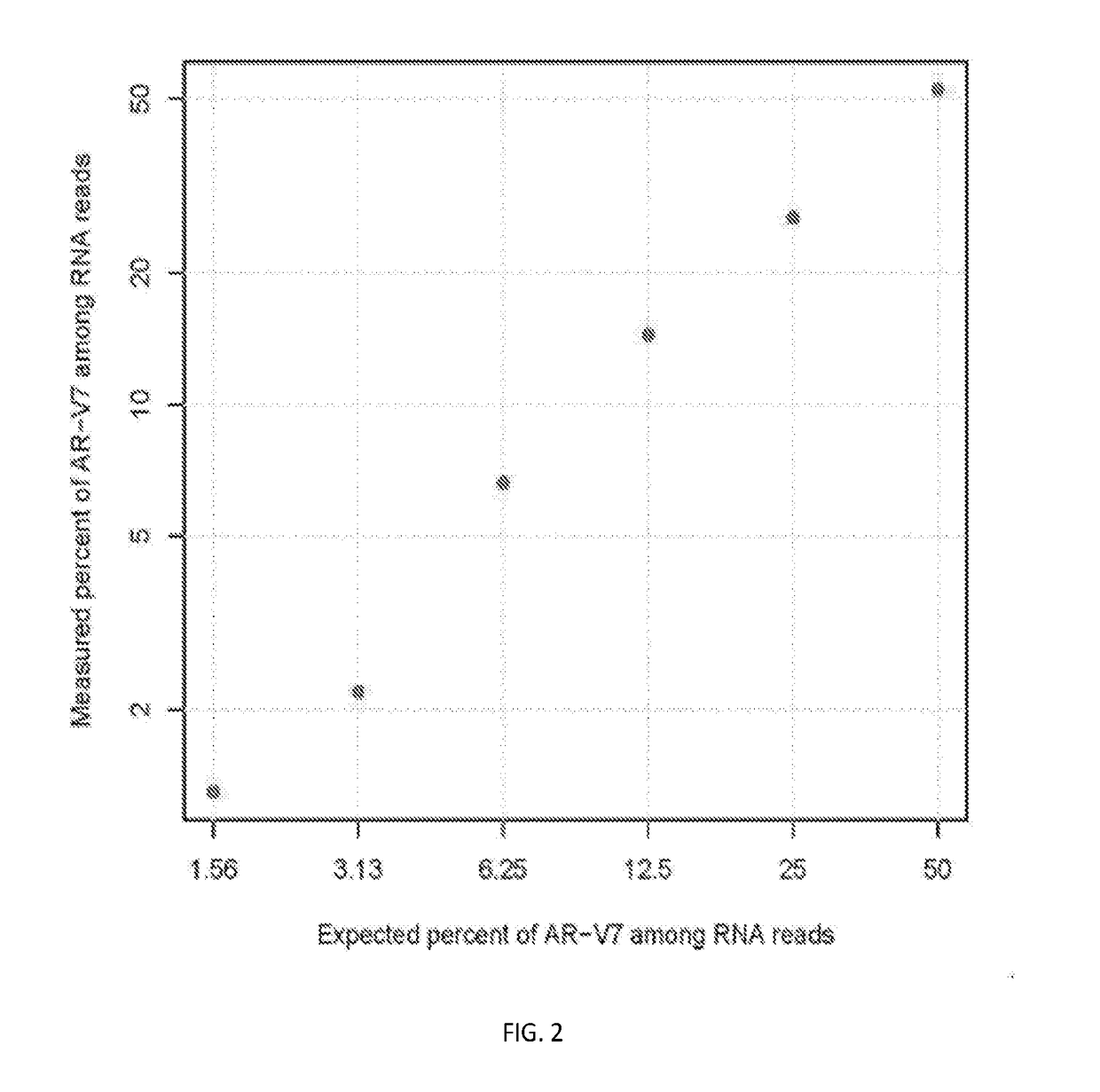Systems and methods for detecting genetic alterations
a genetic alterations and system technology, applied in the field of precision medicine, can solve problems such as limiting the potential of ctc-based detection of rna splicing variants, and achieve the effect of increasing sensitivity and specificity
- Summary
- Abstract
- Description
- Claims
- Application Information
AI Technical Summary
Benefits of technology
Problems solved by technology
Method used
Image
Examples
example 1
Detection of Spiked in ARVs Oligos in cfDNA Extracted from a Biofluid Sample
[0072]The example describes the detailed steps of assaying the presence or absence of one or more androgen receptor gene splice variants (AR-Vs) in a biofluid sample with spiked in AR-Vs and AR-FL (WT) oligos in the cfDNA extracted from the biofluid sample.
[0073]In this example, we used the Gene RADAR (RNA and DNA single molecular digital Reading) workflow, as shown in FIG. 1, to process about 5 ml plasma of healthy donor. We used optimized nucleic acid extraction procedure to extract RNA and DNA from plasma. Then cfDNA was size selected using Agencourt AMPure XP beads (Beckman Coulter) and subsequently quantified using Qubit 3.0 fluorometer. To mimic the condition that cDNAs, reverse transcription of targeted AR region, is mixed with cfDNA samples, AR-FL DNA fragment of 139 bp and AR-V7 DNA fragment of 125 bp were synthesized and pre-annealed, and then a mixer of AR-FL DNA fragment and AR-V7 DNA fragment eq...
example 2
Detection of Reverse Transcribed AR-Vs in cfDNA and cfRNA Extracted from a Biofluid Sample
[0075]This example partly illustrates one embodiment of the disclosed method of detecting AR-V7 and AR-FL in castration-resistant prostate cancer patients.
[0076]Similar to Example 1, circulating nucleic acid is extracted from blood plasma samples using optimized nucleic acid extraction procedure. RNA in the above extraction is then reverse transcribed into cDNA.
[0077]In order to quantify the individual RNA molecules, we used two-layer RNA molecular barcoding scheme, as shown in FIG. 1. The first layer RNA molecular barcoding scheme includes adding RNA specific tags plus random molecular barcodes. After cDNA is converted as dsDNA (double-stranded DNA), it was the same as regular ds cfDNA. We then added the DNA level barcodes by ligation of adaptors.
[0078]For reverse transcription step, cDNA Synthesis Mix is prepared by adding sequentially 10× RT buffer, MgCl2, DTT, RNaseOUT, and SuperScript® III...
example 3
Detection of Reverse Transcribed Novel AR-Vs in Circulating Nucleic Acid Extracted from a Biofluid Sample
[0082]Similar to Example 1, circulating nucleic acid was extracted from blood plasma samples using optimized nucleic acid extraction procedure.
[0083]RNA in the above extraction is then reverse transcribed into cDNA. Specifically, in a 0.2 mL PCR tube with total nucleic acid extraction, primer, dNTP mix are mixed. The following cDNA Synthesis Mix was prepared by adding sequentially 10× RT buffer, MgCl2, DTT, RNaseOUT, and SuperScript® III Reverse Transcriptase. The reverse transcription reaction was performed on thermocycler, then heat inactivated. Then RNA was removed. The cDNA synthesis reaction can be stored at −30° C. to −10° C.
[0084]Second strand cDNA synthesis, and following library preparation, Enrichment, Sequencing on illumine NextSeq 500 procedure were same as Example 2.
[0085]FIG. 4 shows one example of detecting multiple AR splicing variants (AR-V1 / V2, AR-V7, AR-V9 and ...
PUM
| Property | Measurement | Unit |
|---|---|---|
| Electrical resistance | aaaaa | aaaaa |
Abstract
Description
Claims
Application Information
 Login to View More
Login to View More - R&D
- Intellectual Property
- Life Sciences
- Materials
- Tech Scout
- Unparalleled Data Quality
- Higher Quality Content
- 60% Fewer Hallucinations
Browse by: Latest US Patents, China's latest patents, Technical Efficacy Thesaurus, Application Domain, Technology Topic, Popular Technical Reports.
© 2025 PatSnap. All rights reserved.Legal|Privacy policy|Modern Slavery Act Transparency Statement|Sitemap|About US| Contact US: help@patsnap.com



